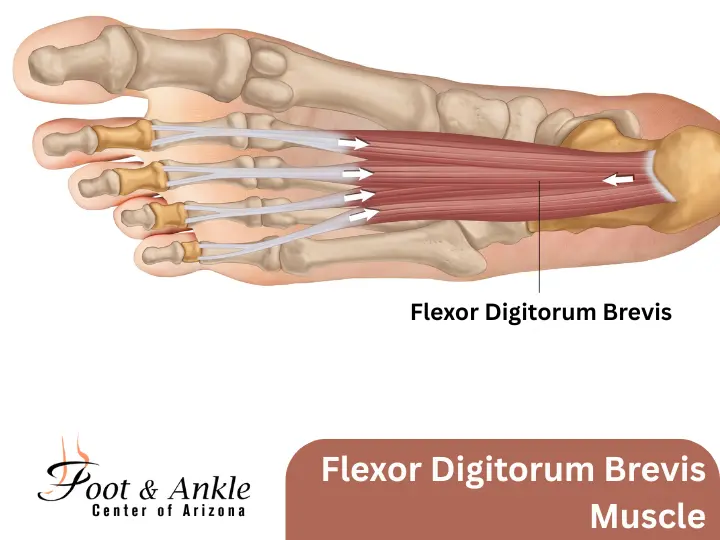Foot pain and dysfunction are often rooted in the complex network of muscles that provide structural support, mobility, and balance. Among these intrinsic foot muscles, the Flexor Digitorum Brevis (FDB) muscle plays a vital yet frequently overlooked role in maintaining proper foot mechanics. At the Foot and Ankle Center of Arizona, led by Dr. Kris A. DiNucci, DPM, FACFAS, we prioritize detailed assessment and evidence-based care for conditions involving the FDB and other key soft tissue structures of the foot.
This article offers an in-depth overview of the Flexor Digitorum Brevis muscle, including its anatomical function, common pathologies, diagnostic considerations, and treatment options.
Anatomical Overview of the Flexor Digitorum Brevis Muscle
The Flexor Digitorum Brevis is a key component of the first muscular layer of the plantar foot, situated just beneath the plantar fascia.
Origin and Insertion:
- Origin: Medial process of the calcaneal tuberosity and the plantar aponeurosis.
- Insertion: Divides into four tendons that insert on the middle phalanges of the 2nd through 5th toes.
- Action: Flexion at the proximal interphalangeal (PIP) joints of the lateral four toes.
Neurovascular Supply:
- Innervation: Medial plantar nerve (branch of the tibial nerve).
- Blood Supply: Medial and lateral plantar arteries.
This muscle acts synergistically with other plantar flexor muscles to support the longitudinal arch, absorb shock, and facilitate toe grip during gait.
Functional Significance
The Flexor Digitorum Brevis muscle contributes to several critical functions in locomotion and postural stability:
- Toe Flexion: Assists in flexing the second through fifth toes, which is important for push-off during gait.
- Arch Stabilization: Provides dynamic support to the medial longitudinal arch of the foot.
- Shock Absorption: Plays a role in dissipating ground reaction forces during walking or running.
- Fine Motor Control: Aids in maintaining grip and balance on uneven terrain.
Pathophysiology: Flexor Digitorum Brevis Muscle Pain and Dysfunction
Muscular dysfunction or injury involving the Flexor Digitorum Brevis may result from repetitive mechanical overload, biomechanical imbalances, or nerve entrapment. While often overshadowed by more common conditions like plantar fasciitis, FDB pathology can significantly affect quality of life.
Common Causes of FDB-Related Pain:
Overuse Syndromes
Athletes, dancers, or individuals engaged in occupations requiring prolonged standing may develop repetitive strain injuries of the FDB.
Improper Footwear
Shoes lacking adequate arch support or cushioning can increase stress on the muscle, particularly in individuals with flat feet or high arches.
Plantar Fasciitis Association
Because of its anatomical proximity and interaction with the plantar fascia, FDB involvement is frequently seen in chronic plantar fasciitis cases.
Traumatic Injury
Acute strain or contusion can result from high-impact activities or sudden plantar flexion.
Neurological Conditions
Compression of the medial plantar nerve may indirectly affect the FDB’s function, leading to localized pain or muscular weakness.
Clinical Presentation
Patients with Flexor Digitorum Brevis muscle dysfunction may present with symptoms such as:
- Localized arch pain or discomfort along the central plantar foot
- Pain with toe flexion, especially during walking or running
- Tenderness to palpation over the medial plantar surface
- Muscular fatigue or cramping during or after activity
- Difficulty bearing weight or pushing off the toes
Differentiating FDB-related pain from other plantar conditions is essential for accurate diagnosis and effective treatment planning.
Diagnostic Approach
A thorough clinical evaluation by a qualified podiatric specialist is crucial for diagnosing FDB-related issues. At the Foot and Ankle Center of Arizona, we utilize advanced diagnostic tools to evaluate soft tissue structures of the foot in detail.
Diagnostic Techniques:
- Physical Examination: Includes palpation of the plantar surface, muscle testing, and gait evaluation.
- Musculoskeletal Ultrasound: Provides high-resolution imaging of soft tissue pathology, including muscle inflammation or tears.
- MRI (Magnetic Resonance Imaging): Utilized in cases of complex or chronic pain to assess deeper tissue structures.
- Nerve Conduction Studies: Considered when neuropathic symptoms suggest medial plantar nerve involvement.
- Gait Analysis: Identifies biomechanical factors contributing to abnormal foot loading.
A differential diagnosis may include conditions such as plantar fasciitis, tarsal tunnel syndrome, flexor hallucis longus strain, and intrinsic muscle atrophy.
Conservative Management and Treatment Options
The majority of Flexor Digitorum Brevis injuries or strains can be managed successfully with conservative, non-surgical interventions. Our approach at the Foot and Ankle Center of Arizona is personalized to each patient’s symptoms, lifestyle, and clinical findings.
Non-Surgical Treatment Strategies:
Activity Modification
Temporary reduction in high-impact or repetitive activities is essential to allow muscle healing.
Custom Orthotics
Prescription orthotic devices help redistribute pressure, support the arch, and reduce mechanical strain on the FDB.
Supportive Footwear
Footwear with appropriate cushioning and arch support reduces muscular overload.
Physical Therapy
A tailored program including:
- Stretching and strengthening exercises
- Proprioceptive training
- Soft tissue mobilization and massage
- Toe flexion drills for neuromuscular re-education
Pharmacologic Management
Nonsteroidal anti-inflammatory drugs (NSAIDs) may be prescribed to manage pain and inflammation.
Icing and Elevation
Regular cryotherapy can alleviate discomfort in acute phases.
Ultrasound or Laser Therapy
These adjunct therapies may assist in enhancing tissue repair and reducing inflammation.
When Surgery is Considered:
Surgical intervention is rarely required and typically reserved for chronic cases unresponsive to conservative care, or in cases involving structural deformities or muscle rupture.
Prevention of Flexor Digitorum Brevis Muscle Strain
Preventative strategies focus on maintaining muscular balance, supporting proper biomechanics, and minimizing risk factors.
Recommendations:
- Engage in regular foot-strengthening exercises
- Stretch the plantar fascia and Achilles tendon
- Wear professionally fitted footwear
- Replace athletic shoes regularly
- Use custom orthotics if you have abnormal arch mechanics
- Avoid prolonged barefoot walking on hard surfaces
Most Common FAQs
1. What is the Flexor Digitorum Brevis muscle and what does it do?
The Flexor Digitorum Brevis muscle is an intrinsic muscle located on the sole of the foot. It originates from the heel bone (calcaneus) and inserts into the middle phalanges of the 2nd through 5th toes. Its primary function is to flex the middle joints of the lesser toes, assist in arch support, and contribute to balance and stability during walking and running.
2. What causes pain in the Flexor Digitorum Brevis muscle?
This pain is commonly caused by overuse, improper footwear, flat feet, plantar fasciitis, or muscle strain. Activities such as running, prolonged standing, or barefoot walking on hard surfaces can overload this muscle. It may also be affected by nerve entrapments or biomechanical imbalances in the foot.
3. How is Flexor Digitorum Brevis muscle pain diagnosed?
Diagnosis of Flexor Digitorum Brevis muscle dysfunction typically involves a clinical foot exam, gait analysis, and musculoskeletal ultrasound or MRI imaging to assess muscle inflammation, strain, or associated soft tissue conditions. A podiatrist may also perform specific muscle testing and palpation to pinpoint the source of pain.
4. What is the treatment for Flexor Digitorum Brevis muscle injury?
Treatment for a Flexor Digitorum Brevis muscle injury often includes rest, ice therapy, supportive footwear, custom orthotics, physical therapy, and anti-inflammatory medications. In chronic or complex cases, advanced treatments such as ultrasound therapy or platelet-rich plasma (PRP) injections may be recommended by a podiatric specialist.
5. How can I prevent Flexor Digitorum Brevis muscle strain?
To prevent Flexor Digitorum Brevis muscle strain, wear supportive, well-cushioned footwear, use custom orthotics if needed, avoid overtraining, and regularly perform foot-strengthening and stretching exercises. Maintaining proper foot mechanics and avoiding barefoot walking on hard surfaces can significantly reduce the risk of injury.
Expert Care for Foot Muscle Conditions in Scottsdale, AZ
At the Foot and Ankle Center of Arizona, our team is dedicated to providing advanced, evidence-based care for patients with intrinsic foot muscle conditions, including injuries involving the Flexor Digitorum Brevis muscle. Led by board-certified podiatric foot and ankle surgeon Dr. Kris A. DiNucci, we specialize in diagnosing and managing complex foot pain using the latest in diagnostic technology, conservative therapy, and surgical intervention when necessary.
Conclusion
The Flexor Digitorum Brevis muscle is a fundamental structure in the architecture of the foot, playing a critical role in toe flexion, balance, and arch support. Understanding its function, recognizing signs of dysfunction, and seeking timely intervention can help prevent long-term complications and improve mobility.
If you are experiencing persistent arch pain or difficulty with toe movement, contact the Foot and Ankle Center of Arizona in Scottsdale today to schedule a comprehensive evaluation and receive expert treatment tailored to your needs.




